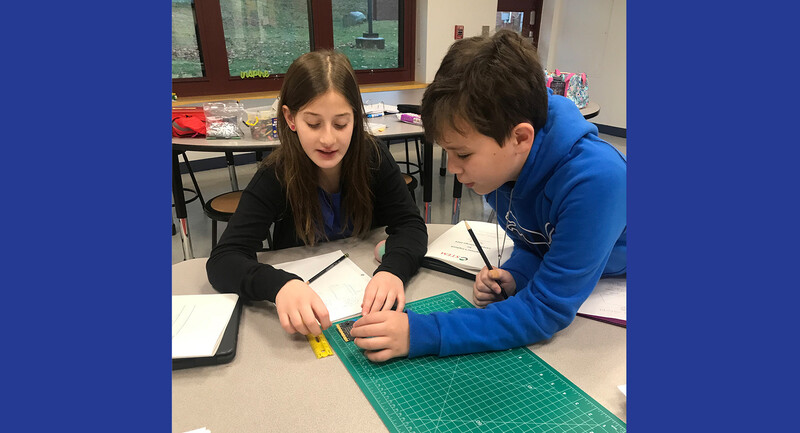Fixed mindsets are among the most sinister impediments to student growth, particularly because they are so pervasive among students and teachers alike. We have all heard from countless students the following self-fulfilling utterance: "I'm not a good writer."
The truth is, although some of our students are undoubtedly gifted with an inherent natural strength for writing, all our students can become good writers.
Such optimism may seem naïve. Indeed, some readers' brows may be furrowed in skepticism, wondering whether I speak from experiences teaching in affluent school districts, where students are privileged, classes are small, and after-school programs provide enrichment. Before I share the practices my peers and I have developed that have resulted in extraordinary growth in our students' writing abilities, let me assure readers that that's not the case.
I teach at Mastery Charter School Shoemaker Campus, an urban public school, serving grades 7–12 in West Philadelphia. Ninety percent of our students receive free lunches; 28 percent receive special education supports. We are a neighborhood school serving a proud, extraordinary, strong, and ambitious community—simultaneously strengthened by the wisdom of elders, community activists, and our vibrant young people, and challenged by the traumas of violence, poverty, and systemic oppression.
So you might wonder how it is that our graduating seniors' scores on college placement exams often demonstrate college readiness. Or how we've ensured that Shoemaker's seniors graduate having written more than 50 multi-page essays in their senior year alone, including using primary and secondary sources for literary analysis term papers and mastering MLA style for citing these sources. The answer, in short, is a combination of rigorous expectations, a student-centered approach to teaching writing, and explicit guidance, with appropriate feedback and modeling, on how to get from point A to point B.
A Visual Indicator of "We Can"
Among the first things students notice when they enter my classroom in August is the large IR (Independent Reading) whiteboard. The whiteboard is divided into five columns, one for each of my classes (three World Literature, two AP Literature). Each column lists students' names alphabetically, followed by a zero. Inevitably, one student will exclaim, "How do I already have a zero!" Such is my cue to explain the process and purpose of the IR Whiteboard.
The IR whiteboard is perhaps the single most important factor in turning every one of my 125+ students into competent, capable, and effective writers. Every week, students are expected to independently read a text I provide and compose a thematic piece of analysis of that text of no more than three pages. At first, all students read the same text; later, reading selections are individualized based on student choice. The numbers adjacent to students' names on the whiteboard indicate the number of these assignments each learner has completed on time, serving as both a visual indicator of success and a visual reminder of room for student growth.
My students, upon hearing these expectations, are thunderstruck. "Impossible," they proclaim. "I'll never be able to do this; I don't even have a computer," they insist. "I can't even write one page," they mutter. I hear them all, honoring their voices for what they are: honest requests for support from young people who, trapped in their fixed mindsets, doubt their abilities to succeed. "I hear you," I say. "And I will help you. You can do this. You just don't know it yet. We will get there together." Usually, they nod their heads. They may not believe it yet, but they're willing to try.
Fixing
With these expectations in place, what's needed next is the proper teacher mindset. I keep this quote (which my mother kept on her desk back when she was teaching) tacked up in my classroom: "If children cannot learn the way we teach, we had better teach the way the child can learn." I find myself murmuring this mantra when I scan over the first week's worth of writing assignments. Nearly across the board, the writing is weak—rambling stream-of-consciousness with nary a thesis in sight, minefields of comma splices and other errors. It's enough to deflate the spirit of even the most optimistic educator.
At this moment, I face the choice most writing teachers face when they confront seriously bad student writing: How should I approach these students? Blame them for demonstrating the skills they lack? Write them off as students who can't write? In other words, match their own fixed mindsets ("I can't write") with one of my own?
If we want our students to become the successful writers they can and should be, we can't take this approach. Instead, we must begin thinking about what specific supports to offer (more on the best one I've found in a moment). If our students haven't learned to write through the way they've been taught in the past, we had better teach them so they will learn in the present. If we want our students to put themselves out there and take the risk of attacking something difficult, we have to meet them where they are, honor their effort, identify and name their areas for growth, and provide attainable next steps.
The "Mad-Libs" Method
When we think of "writing" through the lens of great literature, it's easy to view it as an intangible art form based on genius and inspiration, a skill handed down from above. But it doesn't have to be that way. When we really think about what we want our students to be able to do, it's not necessarily to produce the next wave of magical realism or compose the 21st century's Ulysses or a modern-day Invisible Man. We want our students to be able to write clearly and effectively. We want them to be able to assert a point and defend that point with evidence. We want them to be able to decode an author's argument, identifying strengths and weaknesses of that argument. We want them to be able to use the conventions of proper English when appropriate. Above all, we want them to write and be understood.
One way to accomplish these things may not please the literary purists of the world. But such is the risk I'm willing to take if it means my students can become competent, confident, and effective writers: I give students a template to fill in for each assignment, inspired by—yes—the old Mad Libs game.
I remember early in my teaching career trying to figure out what exactly it was that kept my students from writing an effective essay. What was it that made their essays lack a central point of cohesion? Why could they so rarely transcend summarizing to explain how a particular piece of textual evidence served to support a central argument? The answer struck me as absurdly obvious: They had never been given a map to do so.
This brought to mind the Mad-Libs of my youth, those little stories full of blanks that kids would fill in with adjectives, nouns, verbs, and so on to create whimsical or absurd stories. For all of Mad-Libs' silliness, I still know of few exercises better for mastering parts of speech. I decided to apply the format of the Mad-Lib to the construction of the essay.
No longer do I just tell students, "write a thesis paragraph" or "remember to include a topic sentence." Just imagine being a student who has been given those very instructions year after year, without ever actually being shown how to write these things. Instead, I might put up a slide that looks like this:
Intro Paragraph Format: In [Text Name], [Author's Last Name]'s use of [Adjective] [Literary Method] gets readers to see that [Central Idea]. [Author's Last Name] does this by specifically discussing how [Examples from text 1, 2, and 3]. [Author's Last Name] does all of this to analyze [Thematic Idea].
I explain that students should follow this template, filling in the blanks with what they notice and conclude from reading the text. I give a different template for each assignment. Students rarely demonstrate mastery without several at-bats. This is a messy process, and part of its effectiveness is rooted in its messiness. Students often demonstrate that they don't understand a particular literary method or how to succinctly reference a piece of text. They struggle to make the leap from filling out a template to actually writing with confidence and clarity, and often have to be re-taught, say, what distinguishes a noun from an adjective or verb.
It's important to strategically identify student work to put under a doc-cam. If I see that many students are confusing literary methods for thematic components, for example, I'll select two pieces of student writing, one that demonstrates misunderstanding of these concepts and one that demonstrates mastery. As a class, students can identify mistakes in the first student's work by referencing our anchor charts and templates. Students can then juxtapose these errors against the sample that showed mastery. Soon, light bulbs flash as students actually see the difference between weak, ineffective writing and strong, clear writing.
After much practice of specific skills, a student will readily be able to produce something along these lines:
In "Marionettes, Inc.," Bradbury's use of humorous irony, inter-personal conflict, and a sinister tone gets readers to see the negative effects of technology on people's relationships. Bradbury does this specifically by discussing how two men, Braling and Smith, turn to cyborg doppelgängers as a means to free themselves from their oppressive marriages. Specifically, Braling's desire to leave his wife, Smith's discovery of his wife's betrayal, and Braling 2's violence towards Braling at the conclusion of the story show how the dependence on technology can undermine even the strongest relationships between husbands and wives.
Not bad. It may not be poetry, but it's clear, effective, and insightful. It's precisely what we want our students to be able to do and precisely what college professors say all too often their first-year students cannot produce.
Once we've convinced students that they can write, the only thing they need to be shown is—how. And once we give them a map, students will take it from there. I've found if students feel respected and encouraged, while also held accountable for high expectations, they will often work tirelessly, pushing themselves farther than they had thought possible.
Teaching students—no matter who they are or where they come from—how to write, isn't magic. It doesn't require a series of charmed incantations. Such ideas around teaching the art of writing are, I believe, one of several reasons many students struggle to become strong writers—and one of several mindsets teachers should challenge in themselves. We must break out of our fixed mindsets to help students break out of theirs.








